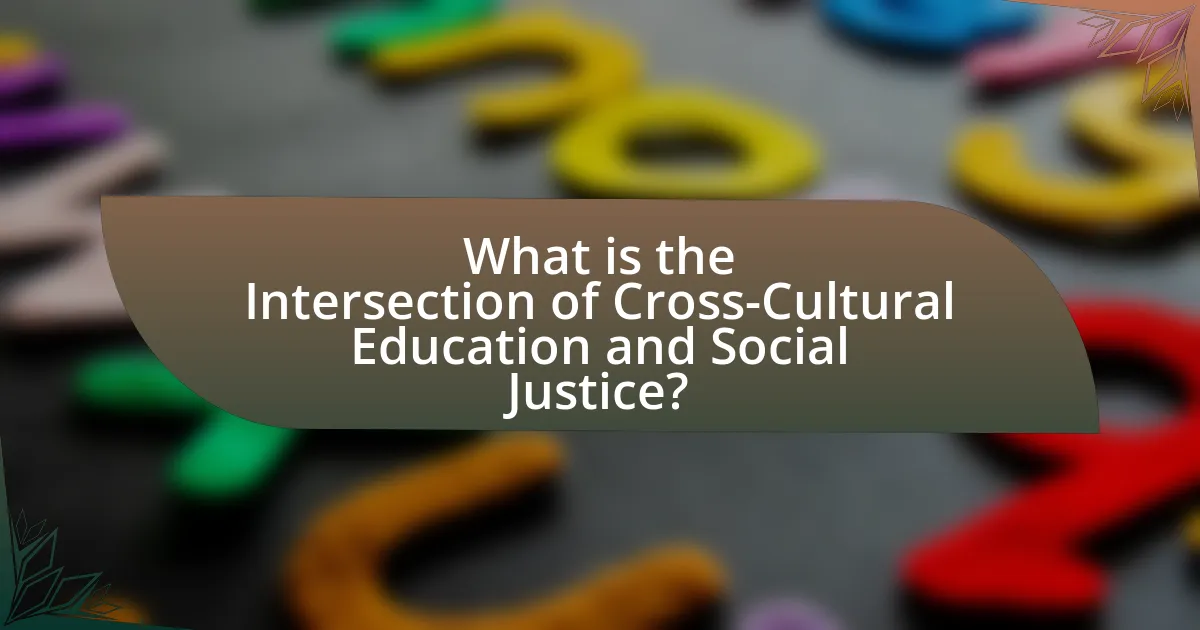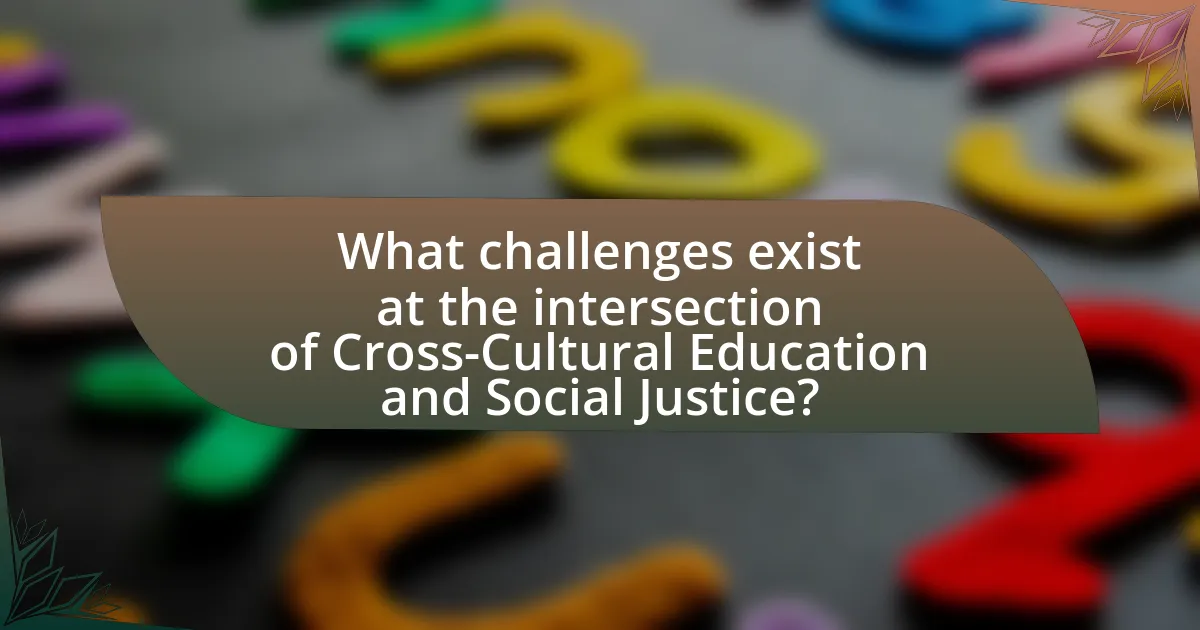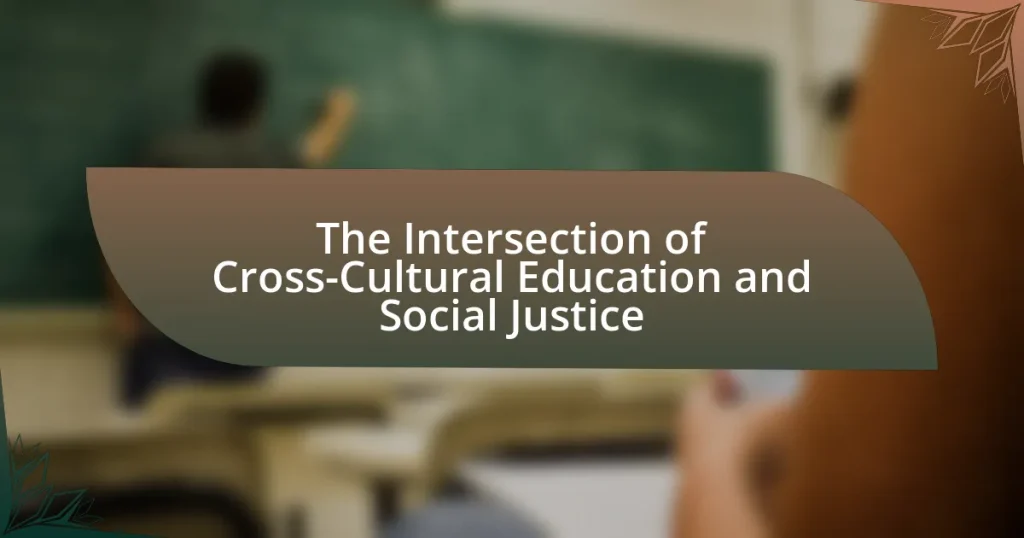The article examines the intersection of cross-cultural education and social justice, emphasizing the importance of creating equitable learning environments that respect diverse cultural perspectives. It discusses how cross-cultural education enhances understanding and appreciation of different cultures, while social justice focuses on fairness and equality in educational access and outcomes. Key principles such as respect for diversity, cultural awareness, and inclusivity are outlined, alongside the challenges educators face, including systemic inequities and cultural bias. The article also highlights effective practices for integrating these fields, including culturally responsive teaching and community engagement, to promote social justice and improve educational equity.

What is the Intersection of Cross-Cultural Education and Social Justice?
The intersection of cross-cultural education and social justice lies in the commitment to fostering equitable learning environments that respect and integrate diverse cultural perspectives. Cross-cultural education aims to enhance understanding and appreciation of different cultures, while social justice emphasizes the need for fairness and equality in educational access and outcomes. Research indicates that inclusive educational practices can reduce disparities in achievement and promote social cohesion, as seen in studies like “Culturally Responsive Teaching: Theory, Research, and Practice” by Geneva Gay, which highlights the positive impact of culturally relevant pedagogy on student engagement and success.
How do cross-cultural education and social justice relate to each other?
Cross-cultural education and social justice are interconnected as both aim to promote equity and understanding among diverse populations. Cross-cultural education fosters awareness and appreciation of different cultures, which is essential for addressing social injustices that arise from cultural misunderstandings and biases. For instance, research by Banks (2016) in “Cultural Diversity and Education” highlights that inclusive educational practices can reduce prejudice and promote social cohesion, thereby supporting social justice initiatives. This relationship underscores the importance of integrating cross-cultural perspectives into educational frameworks to create a more equitable society.
What are the key principles of cross-cultural education?
The key principles of cross-cultural education include respect for diversity, cultural awareness, inclusivity, and critical pedagogy. Respect for diversity emphasizes valuing different cultural backgrounds and perspectives, fostering an environment where all students feel acknowledged. Cultural awareness involves understanding and appreciating the cultural contexts that shape students’ experiences and learning styles. Inclusivity ensures that educational practices accommodate diverse learners, promoting equitable access to resources and opportunities. Critical pedagogy encourages students to question societal norms and injustices, empowering them to engage in social change. These principles are supported by research indicating that culturally responsive teaching improves student engagement and academic outcomes, as highlighted in studies by Gay (2010) and Ladson-Billings (1994).
How does social justice manifest in educational contexts?
Social justice manifests in educational contexts through equitable access to resources, inclusive curricula, and the promotion of diverse perspectives. Educational institutions implement policies that aim to eliminate disparities in funding, technology, and support services, ensuring that all students, regardless of their background, have the opportunity to succeed. For example, research by the National Center for Education Statistics indicates that schools in low-income areas often receive significantly less funding than those in affluent neighborhoods, highlighting the need for equitable resource distribution. Additionally, inclusive curricula that reflect diverse cultures and histories foster a sense of belonging and respect among students, which is essential for social cohesion and understanding. Programs that encourage critical thinking about social issues further empower students to engage in advocacy and community action, reinforcing the principles of social justice within the educational framework.
Why is the intersection of these two fields important?
The intersection of cross-cultural education and social justice is important because it fosters understanding and equity among diverse populations. This integration promotes inclusive educational practices that recognize and value cultural differences, which is essential for addressing systemic inequalities in society. Research indicates that culturally responsive teaching improves student engagement and academic outcomes, particularly for marginalized groups, thereby contributing to social justice by empowering these communities.
What impact does cross-cultural education have on social justice initiatives?
Cross-cultural education significantly enhances social justice initiatives by fostering understanding and empathy among diverse groups. This educational approach equips individuals with the knowledge and skills to recognize and challenge systemic inequalities, promoting inclusivity and equity. Research indicates that programs emphasizing cross-cultural competencies lead to increased civic engagement and advocacy for marginalized communities, as evidenced by studies showing that participants in such programs are more likely to support policies aimed at reducing social disparities.
How can social justice enhance cross-cultural educational practices?
Social justice enhances cross-cultural educational practices by promoting equity, inclusivity, and respect for diverse cultural perspectives. This approach fosters an environment where all students feel valued and empowered, leading to improved engagement and academic outcomes. Research indicates that when educational systems incorporate social justice principles, such as culturally relevant pedagogy, students from marginalized backgrounds demonstrate higher levels of achievement and self-efficacy. For instance, a study by Ladson-Billings (1995) highlights that culturally relevant teaching not only improves student performance but also encourages critical thinking about social issues, thereby enriching the educational experience for all learners.

What challenges exist at the intersection of Cross-Cultural Education and Social Justice?
Challenges at the intersection of Cross-Cultural Education and Social Justice include systemic inequities, cultural misunderstandings, and resistance to change. Systemic inequities manifest in educational policies that often favor dominant cultures, leading to marginalized groups receiving inadequate resources and support. Cultural misunderstandings arise when educators lack cultural competence, resulting in misinterpretations of student behaviors and needs. Resistance to change is prevalent among institutions that may prioritize traditional curricula over inclusive practices, hindering the implementation of social justice principles in education. These challenges impede the effectiveness of cross-cultural education initiatives aimed at promoting equity and understanding among diverse student populations.
What barriers do educators face in implementing cross-cultural education?
Educators face several barriers in implementing cross-cultural education, including lack of training, insufficient resources, and resistance from stakeholders. The lack of training limits educators’ ability to effectively teach diverse perspectives, as many are not equipped with the necessary skills or knowledge to address cultural differences. Insufficient resources, such as access to culturally relevant materials and support systems, further hinders the implementation of cross-cultural education. Additionally, resistance from stakeholders, including parents and school administration, can create an environment where educators feel unsupported in their efforts to promote inclusivity and diversity in the curriculum. These barriers collectively impede the successful integration of cross-cultural education in schools, as highlighted in studies examining educational equity and diversity initiatives.
How do systemic inequalities affect cross-cultural education?
Systemic inequalities significantly hinder cross-cultural education by perpetuating disparities in access to resources, representation, and quality of education. These inequalities manifest through socioeconomic status, race, and geographic location, leading to marginalized groups receiving inadequate educational opportunities. For instance, research by the National Center for Education Statistics indicates that schools in low-income areas often lack essential resources, such as qualified teachers and advanced coursework, which are crucial for effective cross-cultural learning. Consequently, students from diverse backgrounds may experience a curriculum that does not reflect their cultural identities, further alienating them and limiting their engagement in the educational process. This systemic disadvantage not only affects individual learning outcomes but also reinforces broader societal inequities, making it imperative to address these issues for equitable cross-cultural education.
What role does cultural bias play in educational settings?
Cultural bias significantly influences educational settings by shaping curriculum, teaching practices, and student interactions. This bias can lead to the marginalization of certain cultural perspectives, resulting in an educational environment that does not fully represent or respect the diversity of student backgrounds. For instance, research indicates that students from minority backgrounds often experience lower academic performance and engagement due to culturally biased assessments and teaching methods that favor dominant cultural norms. A study by Ladson-Billings (1994) highlights how culturally relevant pedagogy can mitigate these biases, promoting equity and inclusivity in education. Thus, addressing cultural bias is essential for fostering an equitable educational landscape that supports all students.
How can social justice principles address these challenges?
Social justice principles can address challenges in cross-cultural education by promoting equity, inclusivity, and empowerment among diverse student populations. These principles advocate for equal access to educational resources and opportunities, ensuring that marginalized groups receive the support necessary to succeed. For instance, implementing culturally relevant curricula can enhance engagement and understanding, as evidenced by studies showing that students perform better when their cultural backgrounds are acknowledged in the classroom. Furthermore, social justice frameworks encourage collaborative learning environments that respect and value diverse perspectives, which can lead to improved social cohesion and reduced discrimination.
What strategies can educators use to promote equity in cross-cultural education?
Educators can promote equity in cross-cultural education by implementing culturally responsive teaching practices. This approach involves recognizing and valuing students’ diverse cultural backgrounds, which enhances their engagement and learning outcomes. Research indicates that culturally responsive teaching can lead to improved academic performance among marginalized groups, as it fosters a sense of belonging and respect for their identities. Additionally, educators can utilize differentiated instruction to meet the varied learning needs of students, ensuring that all learners have equitable access to educational resources and opportunities. By incorporating diverse perspectives into the curriculum, educators can also challenge stereotypes and promote critical thinking, further supporting equity in the classroom.
How can community engagement support social justice in education?
Community engagement can support social justice in education by fostering inclusive decision-making processes that reflect the diverse needs of all stakeholders. When communities actively participate in educational governance, they can advocate for equitable resources, culturally relevant curricula, and policies that address systemic inequalities. Research indicates that schools with strong community ties often see improved student outcomes, as these partnerships enhance trust and collaboration between educators and families. For instance, a study by the National Education Association found that schools with engaged communities report higher student achievement and lower dropout rates, demonstrating the positive impact of community involvement on educational equity.

What are effective practices for integrating Cross-Cultural Education and Social Justice?
Effective practices for integrating Cross-Cultural Education and Social Justice include implementing culturally responsive teaching, promoting critical consciousness, and fostering inclusive curricula. Culturally responsive teaching involves recognizing and valuing students’ diverse cultural backgrounds, which enhances engagement and learning outcomes. Research by Gay (2010) emphasizes that such practices lead to improved academic performance among marginalized groups. Promoting critical consciousness encourages students to analyze social injustices and develop a sense of agency, as highlighted by Freire (1970) in his work on critical pedagogy. Additionally, fostering inclusive curricula that reflect diverse perspectives ensures that all students see themselves represented in their education, which is supported by studies showing that representation positively impacts student identity and self-esteem.
What teaching methods are most effective for cross-cultural education?
Collaborative learning and experiential learning are the most effective teaching methods for cross-cultural education. Collaborative learning fosters interaction among students from diverse backgrounds, promoting understanding and respect for different perspectives. Experiential learning, which includes real-world experiences and cultural immersion, allows students to engage directly with different cultures, enhancing their empathy and awareness. Research by Deardorff (2006) in “The Identification and Assessment of Intercultural Competence as a Student Outcome of Internationalization” highlights that these methods significantly improve intercultural competence, essential for effective cross-cultural education.
How can experiential learning enhance understanding of social justice?
Experiential learning enhances understanding of social justice by providing individuals with direct, immersive experiences that foster empathy and critical thinking. This approach allows learners to engage with diverse perspectives and real-world issues, facilitating a deeper comprehension of systemic inequalities. For instance, programs that involve community service or social activism enable participants to witness the challenges faced by marginalized groups firsthand, thereby promoting awareness and understanding of social justice concepts. Research by Kolb (1984) on experiential learning emphasizes that active participation in learning processes leads to more profound insights and retention of knowledge, which is crucial for grasping complex social justice issues.
What role does critical pedagogy play in this integration?
Critical pedagogy plays a vital role in the integration of cross-cultural education and social justice by promoting critical consciousness among learners. This approach encourages students to question and challenge societal norms and injustices, fostering an environment where diverse cultural perspectives are valued and understood. Research by Paulo Freire emphasizes that critical pedagogy empowers marginalized voices, enabling them to engage in dialogue and action against oppression. By integrating critical pedagogy, educators can create inclusive curricula that not only reflect diverse cultural narratives but also inspire social change, thereby reinforcing the connection between education and social justice.
How can assessment practices reflect social justice in education?
Assessment practices can reflect social justice in education by ensuring equitable evaluation methods that account for diverse cultural backgrounds and learning styles. These practices can include formative assessments that prioritize student growth over standardized testing, allowing for a more inclusive approach that recognizes individual strengths and challenges. Research indicates that culturally responsive assessments, which incorporate students’ cultural contexts, lead to improved engagement and achievement among marginalized groups. For instance, a study by Ladson-Billings (1994) highlights the importance of culturally relevant pedagogy in fostering academic success for students of color, demonstrating that assessments aligned with social justice principles can enhance educational equity.
What are the best practices for culturally responsive assessment?
Best practices for culturally responsive assessment include using diverse assessment methods, incorporating students’ cultural backgrounds, and ensuring equitable access to resources. Diverse assessment methods, such as performance-based tasks and portfolios, allow for varied expressions of knowledge and skills, accommodating different learning styles. Incorporating students’ cultural backgrounds involves recognizing and valuing their experiences, which can enhance engagement and relevance in assessments. Ensuring equitable access to resources means providing all students with the necessary tools and support to succeed, thereby reducing barriers to achievement. Research by Ladson-Billings (1994) emphasizes the importance of culturally relevant pedagogy, which supports these practices by promoting academic success and cultural competence.
How can feedback mechanisms support social justice goals?
Feedback mechanisms can support social justice goals by facilitating inclusive dialogue and ensuring marginalized voices are heard in decision-making processes. These mechanisms, such as surveys, community forums, and participatory evaluations, allow individuals from diverse backgrounds to express their needs and experiences, which can lead to more equitable policies and practices. For instance, research by the National Equity Project highlights that when feedback is actively sought from underrepresented communities, it results in tailored interventions that address specific social injustices, thereby promoting equity and inclusion.
What practical steps can educators take to foster this intersection?
Educators can foster the intersection of cross-cultural education and social justice by integrating culturally relevant pedagogy into their curriculum. This approach involves recognizing and valuing students’ diverse cultural backgrounds, which enhances engagement and promotes equity in the classroom. Research by Ladson-Billings (1994) highlights that culturally relevant teaching improves student achievement and fosters a sense of belonging among marginalized groups. Additionally, educators should implement collaborative projects that encourage students to explore social justice issues through multiple cultural perspectives, thereby developing critical thinking and empathy. Engaging with local communities and incorporating their voices into the educational process further strengthens this intersection, as evidenced by community-based learning initiatives that have shown positive outcomes in student awareness and activism.
How can educators create inclusive curricula that reflect diverse perspectives?
Educators can create inclusive curricula that reflect diverse perspectives by integrating multicultural content, employing diverse teaching strategies, and actively involving students in the curriculum development process. Incorporating literature, history, and contributions from various cultures ensures representation and fosters understanding. Research indicates that students exposed to diverse perspectives demonstrate improved critical thinking and empathy (Banks, 2016, “Cultural Diversity and Education”). Additionally, utilizing varied instructional methods, such as collaborative projects and discussions, accommodates different learning styles and encourages participation from all students. Engaging students in discussions about their own backgrounds and experiences allows for a more personalized and relevant curriculum, promoting a sense of belonging and respect for diversity.
What resources are available for educators to enhance their practices?
Educators can enhance their practices through various resources such as professional development workshops, online courses, and educational technology tools. Professional development workshops often focus on culturally responsive teaching and social justice education, providing educators with strategies to engage diverse student populations effectively. Online platforms like Coursera and EdX offer courses specifically designed to improve understanding of cross-cultural education and social justice issues. Additionally, educational technology tools, such as Google Classroom and Flipgrid, facilitate collaborative learning and allow educators to implement inclusive practices in their classrooms. These resources are validated by numerous studies indicating that ongoing professional development and the integration of technology significantly improve teaching effectiveness and student engagement in diverse educational settings.
